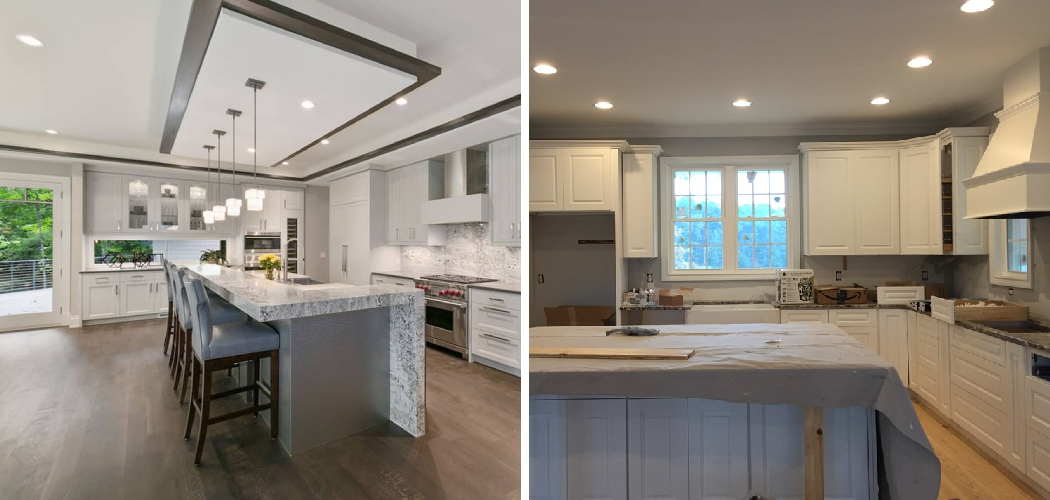Lighting plays an important role in home décor, and a well-lit kitchen can make a world of difference in terms of functionality and ambiance. One of the most popular and effective lighting options for kitchens is can lights.
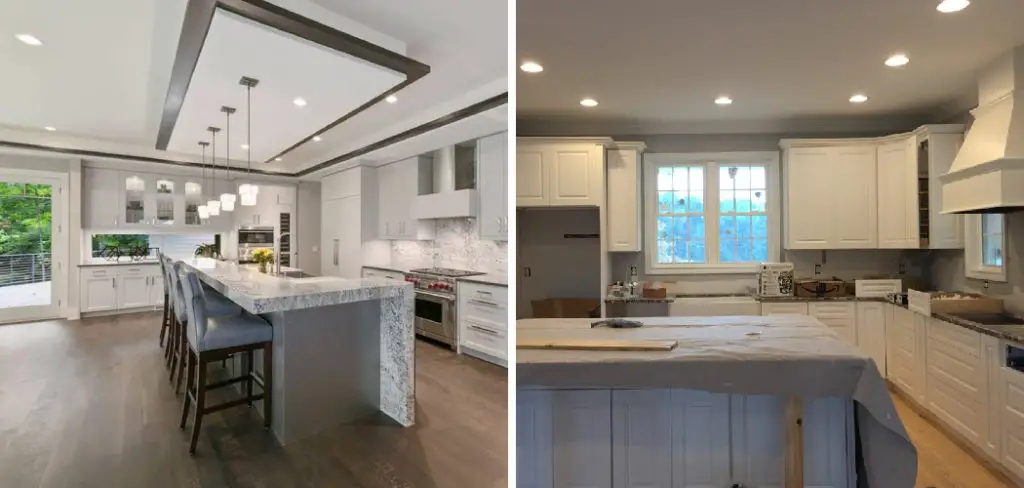
However, proper placement is essential to make sure you achieve the ideal lighting for your space. This blog post will guide you through the steps on how to place can lights in kitchen, so you can achieve the perfect balance of brightness and warmth.
Can You Place a Can Light in The Kitchen?
When it comes to lighting up your kitchen, there are endless options, but can you use a can light in this space? The answer is yes! A can light can be a great addition to your kitchen’s lighting scheme, offering a sleek and modern look that blends seamlessly with the ceiling.
It’s the perfect solution for those who want to keep their space clean and uncluttered without compromising brightness. Plus, lights can come in various sizes and styles, so you can choose one that perfectly matches your kitchen’s aesthetic. So, if you’re looking for a versatile lighting option that’s both understated and effective, a can light may be the perfect choice for your kitchen.
Why Should You Place Can Lights in The Kitchen?
As the heart of the home, the kitchen deserves lighting that illuminates the space and adds visual appeal. That’s where lights can come in. These sleek and subtle fixtures are perfect for kitchen lighting. They blend in seamlessly with the ceiling and provide a soft, warm glow that enhances the beauty of your kitchen.
Can lights also save you time and money since they use energy-efficient bulbs that can last for years? In addition, they offer versatility because you can install them in different patterns and angles to highlight specific areas of the kitchen. With all these benefits, it’s easy to see why can lights are an ideal choice for any kitchen renovation or upgrade.

The Definitive Guide on How to Place Can Lights in Kitchen
1. Determine the Size and Shape of Your Kitchen
Before deciding where to install the can lights, you need to consider the size and shape of your kitchen. Look at the layout of your cabinets, appliances, and countertops to determine the lighting needed in certain areas. For example, you may need more lights above the stove or kitchen island. Once you have a basic idea of the spots that require lighting, you can move on to the next step.
2. Measure the Distance Between the Lights
When placing can lights in a kitchen, it is important to spread them evenly to avoid creating shadows or dark spots. A general rule of thumb is to place the lights 4 feet apart and keep them at least 18 inches from the wall.
You can adjust the measurements based on the size of your kitchen and the specific areas that need more or less lighting. Use a measuring tape to ensure the distance between the lights is consistent throughout the kitchen.
3. Consider Different Types of Can Lights
There are many different types of can lights available, including LED, halogen, and incandescent. Each type has its strengths and weaknesses, such as energy efficiency, brightness, and color temperature.
Consider which type of light will suit your kitchen best based on your personal preference and the overall style of your kitchen. It is also important to consider the cost of each can light, as some options are more expensive than others.
4. Hire a Professional
If you are unsure about how to properly place can lights in your kitchen, it may be a good idea to hire a professional electrician. They can assess your kitchen’s lighting needs and install the lights most efficiently and effectively as possible.

A professional can also help you choose the type of can light that is best for your kitchen and advise on how many lights are needed to create your desired lighting effect.
5. Test Your Lighting
Once your can lights are installed, it is important to test the lighting to ensure it functions properly and achieves the desired effect. Stand in different areas of your kitchen to ensure no dark spots or shadows, and adjust the lights as necessary. Don’t be afraid to experiment with dimmer switches, which can create a softer and more intimate evening lighting effect.
6. Add Other Lighting Fixtures
Can lights are a great option for providing general overhead lighting, but they may not be sufficient to light up the entire kitchen. To add more dimension and depth, incorporate other types of lighting, such as track lights, pendant lights, or wall sconces. These can provide task-oriented lighting in specific areas and create a more inviting atmosphere in the kitchen.
7. Consider Safety Precautions
When installing can lights, it is important to take proper safety precautions. Ensure all wiring and connections are properly secured and checked for any signs of damage or loose wires. If you hire a professional electrician, ensure they are licensed and insured so that you can be assured of their work.
Finally, ensure that all lights are installed at the correct height to avoid any potential hazards or accidents.
Once you have followed these steps, your kitchen’s lighting should be complete! Enjoy the new look and feel of your newly illuminated kitchen space. Now you can enjoy cooking and hosting in a brightly illuminated atmosphere. With the right combination of overhead lighting and task-oriented fixtures, your kitchen will be the perfect place for all of your entertaining needs.
5 Considerations Things When You Need to Place Can Lights in the Kitchen
1. Lighting Layout
The first step when considering can lights in the kitchen is determining what type of lighting layout you want. Do you want a single light in the center of the room or multiple lights around the perimeter?
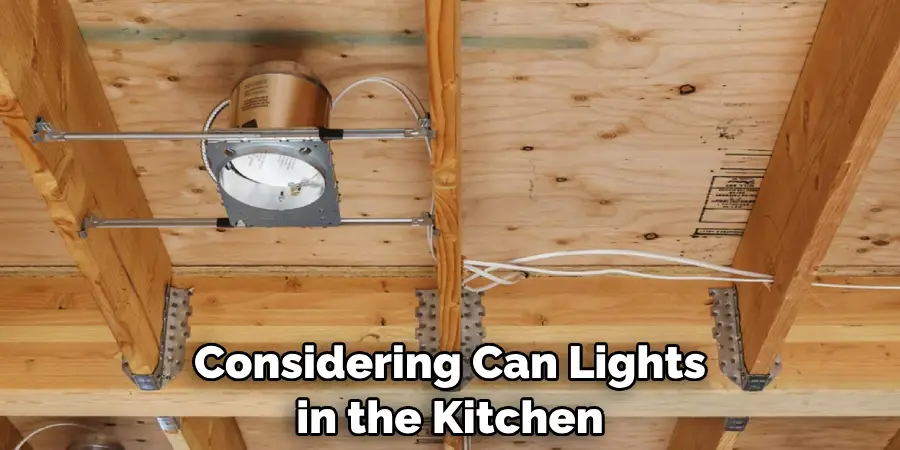
You should also consider how many lights you need and where they should be placed for optimal illumination. Additionally, it’s important to ensure your lighting layout meets all local building codes and regulations.
2. Bulb Type
The next consideration is what type of bulb to use for your can lights. LED bulbs are becoming increasingly popular due to their energy efficiency and long lifespan, while halogen bulbs provide a bright, warm light that is ideal for task lighting. It’s important to choose a bulb type that meets your needs and fits within your budget.
3. Wattage
When selecting can lights for your kitchen, it’s important to consider the wattage of each bulb. The wattage will determine how much light is produced by each bulb, so it’s important to select a wattage that provides enough illumination without being too bright or too dim.
Generally speaking, most kitchens require between 40-60 watts per bulb depending on the room size and other factors such as ceiling height or window placement.
4. Trim Type
Another consideration when selecting can lights for your kitchen is what type of trim you want to use with each fixture. Several different trim types are available, including open trim, baffle trim, and step baffle trim, which all offer different levels of light diffusion and glare control depending on your preference and needs.
5. Dimmable
Finally, it’s important to consider whether or not you want dimmable can lights in your kitchen, as this will give you more flexibility in controlling the amount of light in the space at any given time. Most LED bulbs are dimmable, but some halogen bulbs may require special dimming equipment to be compatible with existing electrical systems, so make sure you check before making a purchase decision.
5 Benefits of Place Can Lights in Kitchen
1. Improved Lighting
One of the main benefits of placing recessed lighting in your kitchen is improved lighting. Recessed lights are designed to be placed flush with the ceiling, providing bright, even light throughout the room. This can make it easier to see while cooking or cleaning and help create a more inviting atmosphere in your kitchen.
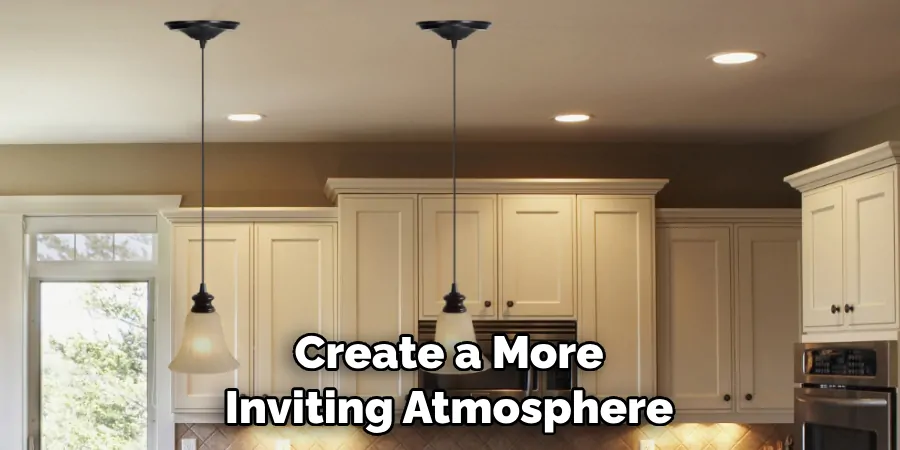
2. Space-Saving Design
Another benefit of recessed lights is that they are a space-saving design. Since they are mounted into the ceiling, they do not take up any floor space like traditional lamps or fixtures would. This makes them ideal for small kitchens where every bit of space counts.
3. Increased Energy Efficiency
Recessed lights are also more energy efficient than traditional lighting fixtures, using less electricity and generating less heat. This can help to reduce your energy costs over time while also helping to protect the environment by reducing your carbon footprint.
4. Easy Installation
Installing recessed lights is relatively easy and can often be done without the help of an electrician. They come with simple instructions that allow you to install them yourself in just a few minutes with minimal effort. This makes them a great option for those who want to upgrade their kitchen lighting without hiring an electrician or paying for expensive installation services.
5. Versatile Design
The versatility of recessed lights also makes them an attractive choice for many homeowners. They come in a variety of sizes and styles that can fit into almost any kitchen design scheme, making it easy to find one that works with your existing decor and layout.
Additionally, since they are installed flush with the ceiling, they won’t take away from other design elements, such as cabinets or countertops, as traditional lamps or fixtures might do.
6 Common Mistakes People Make When Trying to Place Can Lights in Kitchen
1. Not Calculating the Wattage
One of the most common mistakes people make when placing can lights in their kitchen is incorrectly calculating the wattage. The wattage of a light bulb will determine how bright it will be and how much energy it will consume. It’s important to calculate the total wattage of all the bulbs you plan to use before purchasing them, as this will help ensure that your lighting is not too dim or too bright.
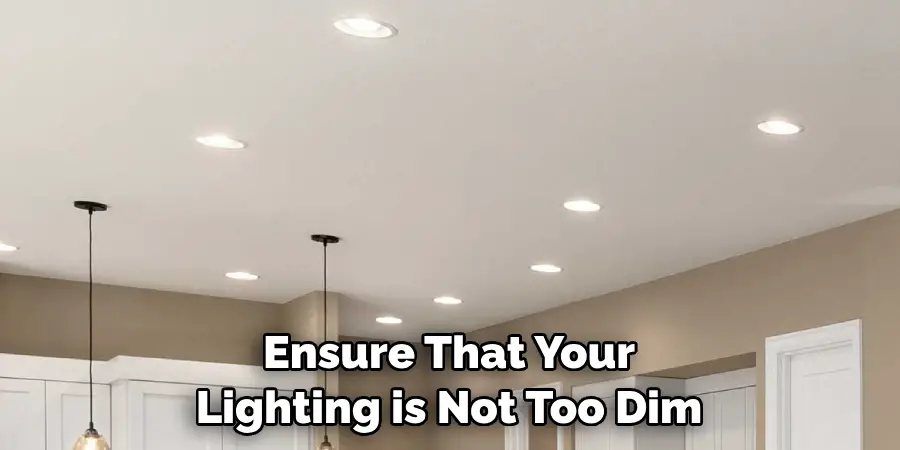
2. Not Taking Ceiling Height into Account
Another mistake people often make when trying to place can lights in their kitchen is not considering ceiling height. The higher your ceiling, the more powerful your lighting should be to provide adequate illumination. If you have a low ceiling, you may want to opt for lower-wattage bulbs to avoid glare on your walls or other surfaces.
3. Placing Lights Too Close Together
It’s also important to ensure you are not placing your can lights too close together. If placed too close, it can create an uneven distribution of light throughout the room and cause shadows in certain areas. It’s best to space out your can lights so that they are evenly distributed throughout the kitchen and provide even illumination for all room areas.
4. Not Using Dimmers
Many people forget about using dimmers when installing can lights in their kitchen, but this is important when considering how much light you need for different tasks and activities within the space. Dimmers allow you to adjust the brightness of each light so that you can customize it according to what type of activity or task you are doing at any given time.
5. Ignoring Recessed Lighting Layout Rules
When placing recessed lighting fixtures, certain layout rules must be followed to achieve optimal results and avoid potential safety hazards such as fire risk or electrical shock from exposed wires or connections.
For example, recessed lighting fixtures should generally be installed no closer than 8 inches away from combustible materials such as wood beams or insulation and no closer than 6 feet away from any water source such as a sink or dishwasher drain line.
6. Not Considering Color Temperature
Finally, many people forget about color temperature when selecting recessed lighting fixtures for their kitchen space; however, this is actually an important factor that must be taken into consideration depending on what type of activities are going on within the space at any given time (e.g., cooking vs. eating).
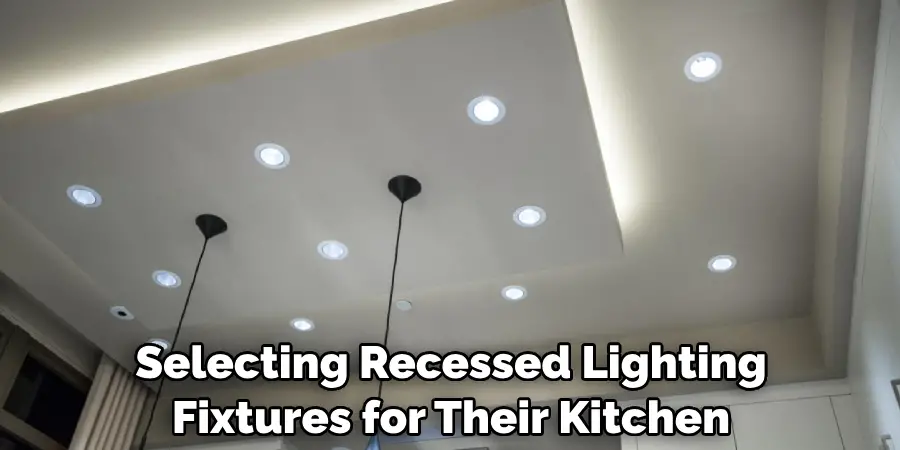
Different colors of light have different effects on our moods and emotions; warmer colors (e.g., yellow/orange) tend to create a cozy atmosphere, while cooler colors (e.g., blue/white) tend to produce a more energizing effect
Conclusion
Now that you know how to properly place can lights in your kitchen, you can create the perfect lighting atmosphere for cooking, entertaining, and relaxing. Whether you prefer a bright and airy ambiance or a dimly lit atmosphere for a romantic dinner, can lights can help you achieve the perfect balance of light and warmth in your kitchen.
Remember to measure the distance between the lights, consider different types of can lights, and test your lighting to ensure it functions properly. And, if you’re uncomfortable with electrical work, a professional electrician can help bring your kitchen lighting dreams to light. Thanks for reading our post about how to place can lights in kitchen.

